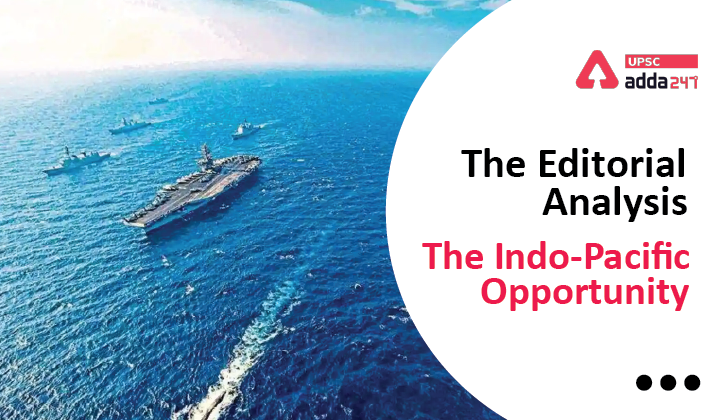Table of Contents
Indo-Pacific: Relevance
- GS 2: Bilateral, regional and global groupings and agreements involving India and/or affecting India’s interests.
Indo-Pacific: Context
- Indo-Pacific region has been undergoing rapid changes due to the presence of many countries and their interests.
- The geopolitics of the region will have to chart a course through inter-state tensions and crises, using both diplomacy and military preparedness.
Broad contours of Indo-Pacific region
- Key players: the US, China, Japan, India, Germany, the UK, Russia, Australia and France.
- The geopolitics and geo-economics of the Indo-Pacific will be largely shaped by the interplay of relations among these nations.
- US-China relations: The relation between both the heavyweights will depend on the following: Differences over Beijing’s south/east China policy, aggressive postures towards Taiwan, human rights violations in Xinjiang, the subjugation of Hong Kong’s citizenry and assertive economic outreach in the Indo-Pacific.
- Arresting China’s adventurism: Groupings like QUAD, AUKUS, have arrested the perception of China’s regional ascendency.
- Moreover, the proposed National Security Strategy (NSS) by Japan are also steps to curb China’s influence over the region.
- India and Australia are on track to deepen ties, not only bilaterally but also with the other two Quad powers.
- Regional groupings: The EU and ASEAN have to balance between the Quad-China interaction.
- Both EU and UK has to be more assertive with China and more cooperative with partners such as India to become vital players in the Indo-Pacific.
- Also, ASEAN must enhance its realism and shed its tendency of wishing away problems as it is the first to face the heat of China’s aggression and the sharpening great power rivalry.
- Global summits: The outcome of three major summits in 2022 — G7, BRICS, G20 — will also impact the politics and diplomacy of the region.
India and the Indo-Pacific
India has three key obligations to remain vital in the region.
- First, to strengthen the Quad by ensuring that the grouping fulfils its commitment to deliver at least one billion vaccine doses to Indo-Pacific nations by December 2022.
- Simultaneously, India must protect its established relationship with Russia, and show resilience in dialogue with China.
- Second, India must enhance cooperation with key Southeast Asian partners —Indonesia, Vietnam, Philippines and Thailand — while humouring ASEAN as a grouping.
- Third, the eastern and southern planks of Africa and the Indian Ocean island states need continued high policy attention and financial resources.
- A clear economic and trade agenda, involving and incentivising corporate India to follow the flag in this vital region, is certain to yield long-term dividends.
Also Read:




 TSPSC Group 1 Question Paper 2024, Downl...
TSPSC Group 1 Question Paper 2024, Downl...
 TSPSC Group 1 Answer key 2024 Out, Downl...
TSPSC Group 1 Answer key 2024 Out, Downl...
 UPSC Prelims 2024 Question Paper, Downlo...
UPSC Prelims 2024 Question Paper, Downlo...





